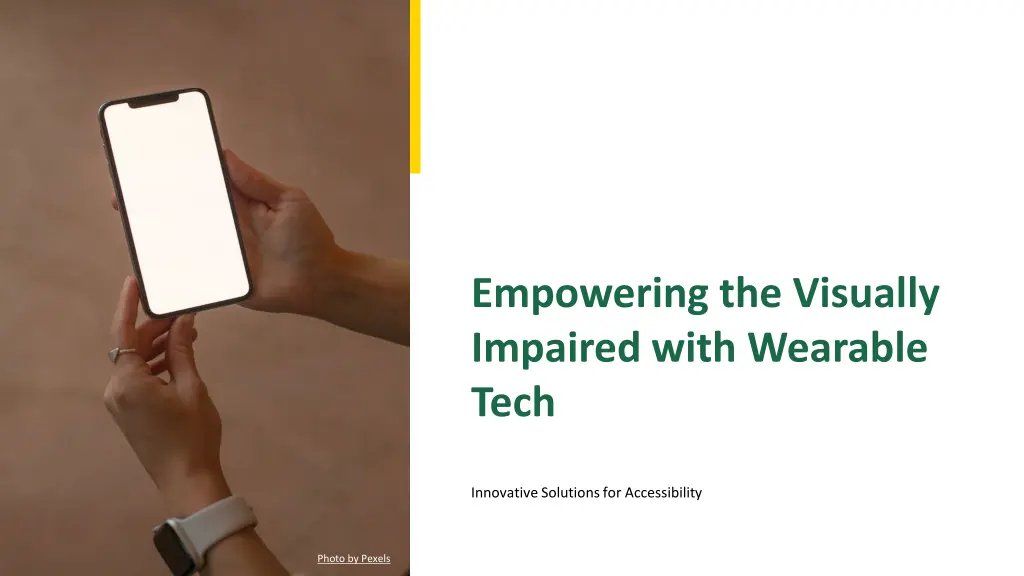
Empowering Visually Impaired with Wearable Tech Innovations
"Explore how wearable assistive technology is transforming the lives of visually impaired individuals, providing independence and accessibility through innovative solutions. Learn about Raspberry Pi's role, real-time text processing, haptic feedback, user-centric design, and applications in education. Discover the impact and future prospects of empowering the visually impaired in this insightful guide."
Download Presentation

Please find below an Image/Link to download the presentation.
The content on the website is provided AS IS for your information and personal use only. It may not be sold, licensed, or shared on other websites without obtaining consent from the author. If you encounter any issues during the download, it is possible that the publisher has removed the file from their server.
You are allowed to download the files provided on this website for personal or commercial use, subject to the condition that they are used lawfully. All files are the property of their respective owners.
The content on the website is provided AS IS for your information and personal use only. It may not be sold, licensed, or shared on other websites without obtaining consent from the author.
E N D
Presentation Transcript
Empowering the Visually Impaired with Wearable Tech Innovative Solutions for Accessibility Photo by Pexels
01 Introduction to Wearable Tech Table of Contents 02 The Raspberry Pi Advantage 03 How It Works 04 Haptic Feedback: A Sensory Boost 05 User-Centric Design 06 Applications in Education 07 Real-World Impact 08 Future Prospects 09 Conclusion 10 Thank You!
1 Introduction to Wearable Tech Revolutionizing Assistance Wearable assistive technology is changing lives by providing support to individuals with visual impairments. This technology enables users to interact with their environmentconfidently and independently. The integration of lightweight devices fosters a hands-free experience for users. Empowerment through technology not only enhances quality of life but also boosts self-esteem. Photo by Pexels
2 The Raspberry Pi Advantage A Game Changer Raspberry Pi serves as a compact and powerful platform for developing assistive technologies. It is cost-effective, promoting accessibility for a wider range of users. The flexibility of Raspberry Pi allows for endless customization and functionalityenhancements. Innovators can leverage its capabilities to design tailored solutions for individual needs. Photo by Pexels
3 How It Works Real-Time Image Capture The wearable reader uses a high-resolution miniature camera to capture printedtext. Users can read physical books effortlessly as the device processes text in real time. Advanced algorithms convert images into audio or tactile feedback for comprehension. This seamless process encourages interaction with printed materials. Photo by Pexels
4 Haptic Feedback: A Sensory Boost Feel the Text The device includes haptic feedback, enhancing the reading experience. Users receive tactile responses that correspond with the text being read. This multisensory approach reinforces understanding and retention of information. Haptic technology allows users to connect with literature in a unique way. Photo by Pexels
5 User-Centric Design For Everyone The wearable reader is designed with input from visually impaired users. Attention to ergonomic features ensures comfort during prolongeduse. Customization options cater to individual preferences and needs. User feedback is crucial in refining technology for better usability. Photo by Pexels
6 Applications in Education Bridging the Gap Wearable assistive technology enhances learning opportunities for visually impairedstudents. It allows access to textbooks and printedmaterials effectively. Students can engage with educational content on equal footing with peers. This technology promotes inclusivity in educational settings. Photo by Pexels
7 Real-World Impact Changing Lives Users report increased independence and confidence when using wearable devices. This technology facilitates participation in various activities and environments. Empowered individuals can pursue careers and hobbies previously thoughtinaccessible. The societal impact extends to fostering inclusivity for all. Photo by Pexels
8 Future Prospects A New Era Ongoing developments in wearable technology promise even more features. Integration with smart devices can create a connected ecosystem for users. Research is focused on enhancing accuracy and response times. The future holds countless possibilities for innovation in assistive tech. Photo by Pexels
9 Conclusion A Vision for All Wearable assistive technology represents a crucial advancement for the visually impaired. It combines innovation with empathy to create meaningful solutions. Our collective commitment to accessibility continues to drive progress. Together, we can envision a world where everyone thrives equally. Photo by Pexels
10 Thank You! Stay Inspired! We appreciate your attention and interest in wearable assistive technology. Together, we can create innovative solutions for a better tomorrow. Your support is vital in driving advancements that empower all individuals. Let s continue to inspire and upliftone another in this journey. Photo by Pexels
